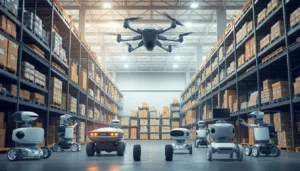In a world where even your toaster might soon have a personality, automation robotics is leading the charge into the future. These clever machines aren’t just here to make life easier; they’re on a mission to revolutionize industries and transform the way we work. Imagine a factory where robots handle the heavy lifting while humans focus on creativity and innovation. Sounds like a sci-fi movie, right? Well, it’s happening right now!
Table of Contents
ToggleWhat Is Automation Robotics?
Automation robotics refers to the use of robotic systems to perform tasks with minimal human intervention. These systems integrate advanced technologies such as artificial intelligence, machine learning, and sensors. Industries leverage automation robotics to enhance efficiency, accuracy, and safety in various processes.
Robots excel at performing repetitive tasks. With increased speed and precision, they outperform humans in roles like assembly line work and material handling. Such capabilities contribute to reducing labor costs and minimizing errors in production environments.
Many sectors implement automation robotics to streamline operations. Manufacturing plants often utilize robots for welding, painting, and packaging. In agriculture, drones monitor crops and automate tasks such as planting and harvesting. These examples show the versatility and adaptability of robotics across different fields.
Organizations benefit significantly from adopting automation robotics. Improved productivity leads to higher output, while freed-up human resources allow for a focus on more complex and creative tasks. This shift results in better job satisfaction and potential for innovation.
Moreover, automation robotics foster workplace safety. By handling hazardous tasks, robots minimize risks associated with human labor. This aspect enhances employee well-being and reduces workplace injuries.
Ultimately, automation robotics represent a critical advancement in modern technology, driving efficiency and innovation in numerous industries. The ongoing development and deployment of these systems indicate a strong future where humans and robots collaborate more closely, shaping the landscape of work dramatically.
Key Components of Automation Robotics
Automation robotics comprise several essential components that enable effective operation and interaction in diverse environments.
Sensors and Actuators
Sensors collect data from the surrounding environment, providing critical input for robotic systems. They detect variables such as temperature, pressure, and proximity, facilitating informed decision-making. Actuators receive commands from the control system and translate them into physical motion, enabling robots to perform tasks. An actuator could control a robotic arm or drive wheels on a mobile robot. Together, these elements ensure robots operate efficiently and respond accurately to various stimuli. Their integration allows for improved precision and adaptability in tasks, enhancing overall functionality in industrial applications.
Control Systems
Control systems serve as the brain of automation robotics, directing the actions based on data from sensors. These systems utilize algorithms to process sensor input and determine the right response. Programmable logic controllers and microcontrollers are common examples of control systems. They execute commands swiftly, ensuring robots function smoothly in dynamic environments. Effective control systems contribute significantly to the reliability and performance of robotic systems. By coordinating movements and processes, they enhance efficiency and consistency in operations across multiple industries.
Applications of Automation Robotics
Automation robotics plays a crucial role across various sectors, enhancing efficiency and accuracy in numerous applications.
Manufacturing Industry
In the manufacturing industry, automation robotics streamline production processes. Robots handle repetitive tasks such as assembly, welding, and painting, consistently performing these functions with precision. They minimize errors and improve productivity, often leading to cost reductions in labor. Many factories deploy robotic arms to work alongside human operators, allowing for greater flexibility and speed in production. Integration of robotics also facilitates real-time monitoring, enabling manufacturers to adapt quickly to changing demands while maintaining quality.
Healthcare Sector
Within the healthcare sector, automation robotics transform patient care and operational efficiency. Robots assist in surgeries, providing enhanced precision and reducing recovery times for patients. Automated systems manage inventory in pharmacies, ensuring that critical medications are always available. In addition, robotic devices support elderly care, helping residents with daily activities and ensuring their safety. By automating various tasks, healthcare professionals can focus on more complex and personalized patient care, improving overall service quality.
Logistics and Warehousing
Logistics and warehousing benefit significantly from automation robotics as they optimize supply chain operations. Automated guided vehicles transport goods effortlessly within warehouses, reducing the time taken for inventory retrieval. Robotics streamline sorting processes, enhancing accuracy in order fulfillment. Companies increasingly rely on robotic systems for handling heavy items, thereby improving workplace safety. Increased automation in logistics enables organizations to respond swiftly to market changes, ultimately enhancing customer satisfaction.
Benefits of Automation Robotics
Automation robotics offers significant advantages across various sectors. Increased productivity, reduced operational costs, and enhanced workplace safety contribute to transforming the landscape of work.
Increased Efficiency
Automation robotics significantly boosts productivity in manufacturing and other industries. Robots handle repetitive tasks with high precision, performing them faster than human workers. This speed reduces production time and maximizes output. In warehouses, robotic systems swiftly sort and package items, expediting order fulfillment processes. Tasks that require consistency, such as assembly and quality control, benefit from robotic capabilities, ensuring minimal errors and higher accuracy. By integrating automation, organizations experience smoother workflows and improved overall efficiency.
Cost Savings
Cost savings represent a critical advantage of automation robotics. Businesses reduce labor costs by minimizing human involvement in repetitive and menial tasks. Robots operate around the clock, increasing production without incurring overtime expenses. As a result, operational costs decrease significantly. The initial investment in robotics technology often leads to long-term financial benefits through enhanced output and efficiency. Organizations also benefit from fewer errors, which reduces waste and rework expenses. Overall, integrating automation robotics contributes to a healthier bottom line.
Improved Safety
Improved safety records result from the deployment of automation robotics. These machines handle hazardous tasks, reducing the risk of injury to human employees. In environments where dangerous materials are present, robots can perform tasks without putting workers at risk. Safety also increases as robots navigate potentially hazardous situations with superior precision. By removing humans from high-risk roles, organizations create safer workplaces. Furthermore, compliance with safety regulations becomes more manageable, positively impacting overall operational standards.
Challenges and Considerations
Automation robotics presents a range of challenges and considerations that businesses need to address. Navigating these issues ensures effective and sustainable integration of robotic systems into various industries.
Job Displacement Concerns
Job displacement stands as a significant concern associated with automation robotics. Many workers fear that widespread implementation of robots may lead to job losses, especially in repetitive roles. Studies indicate that sectors like manufacturing and logistics face the highest risk. While automation can enhance productivity, affected workers may struggle to transition into new positions that require different skills. Employers must prioritize retraining programs to support displaced workers. Addressing this challenge actively ensures that the workforce adapts alongside technological advancements.
Technical Limitations
Technical limitations significantly impact the efficacy of automation robotics. Robotic systems require precise programming and maintenance, posing challenges for organizations lacking technical expertise. Variability in environments can affect a robot’s performance, leading to potential errors. Additionally, autonomy in unstructured environments remains limited, restricting their application in certain settings. Organizations must invest in training and development to mitigate these limitations. Continuous improvement in technology also plays a crucial role in overcoming obstacles associated with robotics.
The rise of automation robotics is transforming industries at an unprecedented pace. As robots take on more physically demanding and repetitive tasks, human workers can shift their focus to creative and strategic roles. This collaboration between humans and machines is not just enhancing productivity but also improving workplace safety and job satisfaction.
While challenges like job displacement and technical limitations exist, proactive measures such as retraining programs can help ease the transition for affected workers. By investing in workforce development and embracing the potential of automation robotics, organizations can position themselves at the forefront of innovation. The future of work is evolving, and those who adapt will thrive in this new landscape.










